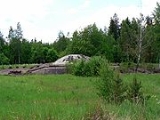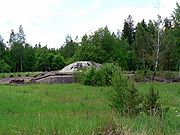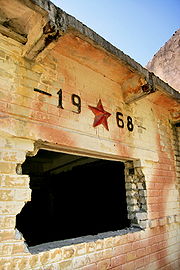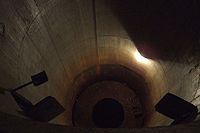
R-12
Encyclopedia

Theatre ballistic missile
A theatre ballistic missile is any ballistic missile with a range between and , used against targets "in-theatre". Its range is thus between that of tactical and intercontinental ballistic missiles. The term is a relatively new one, encompassing the former categories of short-range ballistic...
developed and deployed by the Soviet Union
Soviet Union
The Soviet Union , officially the Union of Soviet Socialist Republics , was a constitutionally socialist state that existed in Eurasia between 1922 and 1991....
during the Cold War
Cold War
The Cold War was the continuing state from roughly 1946 to 1991 of political conflict, military tension, proxy wars, and economic competition between the Communist World—primarily the Soviet Union and its satellite states and allies—and the powers of the Western world, primarily the United States...
. Its GRAU
Grau
Grau is a German word meaning "gray" and a Catalan word meaning "grade". It may refer to:* BAP Almirante Grau , a De Zeven Provinciën class cruiser in service with the Peruvian Navy* Grau Käse, Tyrolean grey cheese...
designation was 8K63, and it was given the NATO reporting name
NATO reporting name
NATO reporting names are classified code names for military equipment of the Eastern Bloc...
SS-4 Sandal. The R-12 rocket provided a capability to attack targets at medium ranges with a megaton-class nuclear warhead and constituted the bulk of the Soviet offensive missile threat to Western Europe. Deployments of the R-12 missile in Cuba caused the Cuban Missile Crisis
Cuban Missile Crisis
The Cuban Missile Crisis was a confrontation among the Soviet Union, Cuba and the United States in October 1962, during the Cold War...
of 1962.
History
OKB-586Yuzhnoye Design Bureau
Yuzhnoye Design Bureau , located in Dnipropetrovsk, Ukraine, is a designer of satellites and rockets, and formerly of Soviet intercontinental ballistic missiles established by Mikhail Yangel. Yuzhnoye's OKB designation was OKB-586....
was formed from a spin-off of portions of Korolev's OKB-1 production infrastructure under the direction of Mikhail Yangel
Mikhail Yangel
Mikhail Kuzmich Yangel , was a leading missile designer in the Soviet Union....
in the early 1950s. Soon after he started the development of an improved strategic missile that would outperform the R-5 (SS-3 Shyster) that Korolev was in the process of bringing into production. Yangel's design was based on combining the basic airframe from the R-5 with an engine developed from the R-11. The R-11 was a short-range missile that used nitric acid
Nitric acid
Nitric acid , also known as aqua fortis and spirit of nitre, is a highly corrosive and toxic strong acid.Colorless when pure, older samples tend to acquire a yellow cast due to the accumulation of oxides of nitrogen. If the solution contains more than 86% nitric acid, it is referred to as fuming...
as oxidizer and kerosene as a fuel, which could be stored for extended periods of time.
Valentin Glushko
Valentin Glushko
Valentin Petrovich Glushko or Valentyn Petrovych Hlushko was a Soviet engineer, and the principal Soviet designer of rocket engines during the Soviet/American Space Race.-Biography:...
had long advocated using storable propellants, and proposed developing a new engine for the project. Earlier designs like the R-5 and R-7 used liquid oxygen
Liquid oxygen
Liquid oxygen — abbreviated LOx, LOX or Lox in the aerospace, submarine and gas industries — is one of the physical forms of elemental oxygen.-Physical properties:...
as its oxidizer, and therefore had to be fueled immediately before launch, as the oxygen would "boil off" over time. He developed the RD-214 for the R-12, which consisted of four combustion chambers sharing a common turbopump
Turbopump
A turbopump is a gas turbine that comprises basically two main components: a rotodynamic pump and a driving turbine, usually both mounted on the same shaft, or sometimes geared together...
assembly. The pumps were powered by decomposing the nitric acid to generate an exhaust. The new engine was too large to fit in the existing R-5 airframe, so a conical tail section was added to hold the engine.
Nikolay Pilyugin, head of the leading control system bureau, convinced Yangel to introduce fully autonomous control system in the R-12 instead of traditional radio control that had been used on earlier missiles. The R-5, for instance, used an inertial guidance system that had to be "fine tuned" by commands from ground radio stations that it passed over during its flight. Pilyugin felt that newer inertial systems would have the accuracy needed to hit targets at 2,000 km without the mid-course updates.
According to the official Yuzhnoye history, Yangel's design was approved on 13 February 1953 by the Council of Ministers of the USSR. However another source reports that the approval was granted on 13 August 1955. The first test was conducted at Kapustin Yar
Kapustin Yar
Kapustin Yar is a Russian rocket launch and development site in Astrakhan Oblast, between Volgograd and Astrakhan. Known today as Znamensk , it was established 13 May 1946 and in the beginning used technology, material, and scientific support from defeated Germany...
on 22 June 1957. In September 1958 Nikita Khrushchev
Nikita Khrushchev
Nikita Sergeyevich Khrushchev led the Soviet Union during part of the Cold War. He served as First Secretary of the Communist Party of the Soviet Union from 1953 to 1964, and as Chairman of the Council of Ministers, or Premier, from 1958 to 1964...
personally visited Kapustin Yar to witness the launch of R-12, as well as its competitor, the R-5M. The latter had already been accepted into deployment at the time. The R-12 launch was a success and the next month, mass production of the vehicle started in Dnepropetrovsk. Test launches continued until December, and demonstrated a maximum error of 2.3 km.
For the work on R-12, on 1- July 1959 OKB-586 received Order of Lenin
Order of Lenin
The Order of Lenin , named after the leader of the Russian October Revolution, was the highest decoration bestowed by the Soviet Union...
, while Hero of Socialist Labor
Hero of Socialist Labor
Hero of Socialist Labour was an honorary title in the Soviet Union and other Warsaw Pact countries. It was the highest degree of distinction for exceptional achievements in national economy and culture...
(the highest industrial award) was awarded to Yangel, Smirnov and Budnik.
Deployment

The first public display of this system was in November 1960, and they were deployed to Cuba in the Fall of 1962 during the Cuban Missile Crisis
Cuban Missile Crisis
The Cuban Missile Crisis was a confrontation among the Soviet Union, Cuba and the United States in October 1962, during the Cold War...
. The first five regiments with surface-based R-12 missiles were put on alert in May 1960, while the first regiment of silo-based missiles was placed on alert in January 1963. Reaction time was assessed by the West at one to three hours in the normal soft site readiness condition, and five to fifteen minutes in the normal hard site readiness condition. The allowable hold time in a highly alert condition (reaction time equals three to five minutes) is long--many hours for soft sites, and days for hard sites.
The R-12 and R-12U missiles reached their maximum operational launcher inventory of 608 in 1964-1966. Some soft-site phase-out began in 1968, with some hard-site phase-out beginning in 1972. In 1978 their phase out and replacement with mobile ground-launched SS-20 "Pioneer" missiles began.
Further development

The R-12 was also used during the development of the V-1000 anti-ballistic missile
Anti-ballistic missile
An anti-ballistic missile is a missile designed to counter ballistic missiles .A ballistic missile is used to deliver nuclear, chemical, biological or conventional warheads in a ballistic flight trajectory. The term "anti-ballistic missile" describes any antimissile system designed to counter...
, serving as a target. During a series of tests two R-12s detonated their warheads in the upper atmosphere in order to test radar systems. A follow-on test planned to launch a R-12 from Kapustin Yar while two R-9's from Tyuratam
Tyuratam
Tyuratam is a station on the main Moscow to Tashkent railway, located in Kazakhstan. The name is a word in the Kazakh language and means "Töre's grave"; Töre, or more formally, Töre-Baba, was a noble, a descendant of Genghis Khan...
would fly into the area, but only the R-12 launched successfully.
Elimination
The Intermediate-Range Nuclear Forces TreatyIntermediate-Range Nuclear Forces Treaty
The Intermediate-Range Nuclear Forces Treaty is a 1987 agreement between the United States and the Soviet Union. Signed in Washington, D.C. by U.S. President Ronald Reagan and General Secretary Mikhail Gorbachev on December 8, 1987, it was ratified by the United States Senate on May 27, 1988 and...
was signed in December 1987 and entered into force in June 1988. The fundamental purpose of the INF Treaty was to eliminate and ban US and Soviet ground-launched ballistic and cruise missiles, as well as associated support equipment, with ranges between 500 and 5500 kilometers. Elimination of SS-4 and SS-5 missiles and components took place at the Lesnaya Missile Elimination Facility. The last of the 149 Soviet SS-4 missiles was eliminated at Lesnaya in May 1990.
Description
The R-12 is a single-stage rocket with a separable single reentry vehicle. In the integrated fuel tanks the oxidizer was put forward of the fuel tank, separated by an intermediate plate. During flight this allowed the oxidizer from the lower unit to be spent first thus improving in-flight stabilization. The propulsion system consists of four liquid propellant rocket motors with a common turbo pump unit. The flight control was carried out with the help of four carbon jet vanes, located in the nozzles of the rocket motors. The autonomous guidance and control system used center of mass normal and lateral stabilization devices, a velocity control system and a computer-assisted automatic range control system. The R-12 was deployed at both soft launch pads and hard silos.Standard nuclear explosive charges of the capacity of 1 Mt were generally used but it was possible to use those of the capacity up to 2,3 Mt. The explosive charges of chemical weapons "tuman" could have been used as well.
R-12 4 steps of readiness
Readiness nr. 4 (constant). The missile is in the hangar. The gyroscopes (control devices) and the explosive charge were unconnected, the missile was unfilled. The missile can stay so for 7 years (factory-guaranteed service time). It takes 3 hours and 25 minutes to start.Readiness nr. 3 (elevated). The missile is in the hangar. The gyroscopes and the explosive charge connected. The Missile can stay so for 3 years. It takes 2 hours and 20 minutes to start.
Readiness nr. 2 (first step elevated). The missile is carried to the starting ground, the gyroscopes are started, initial data inserted. Petrol tanks stood next to the missile. The missile can stay so for 3 months. It takes 1 hour to start.
Readiness nr. 1 (total). The missile is filled up and directed. Starting mixture gas is not tanked up. The missile can stay so for 1 month. It takes 30 minutes to start.

